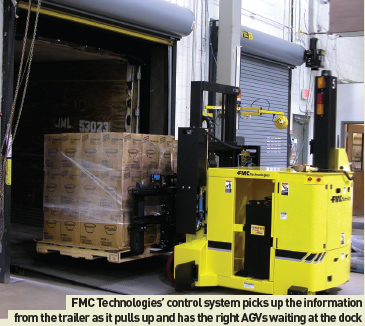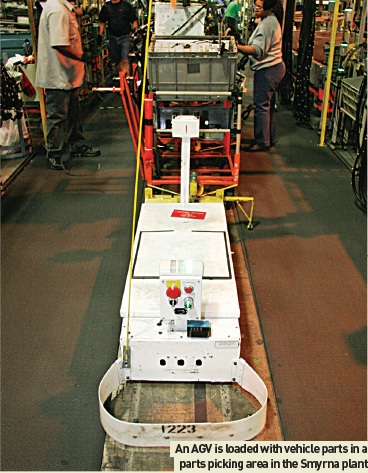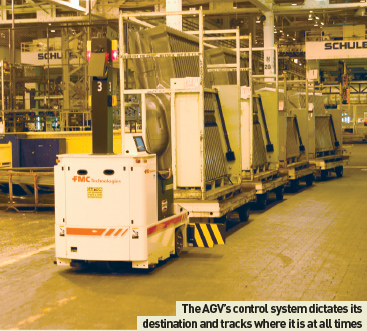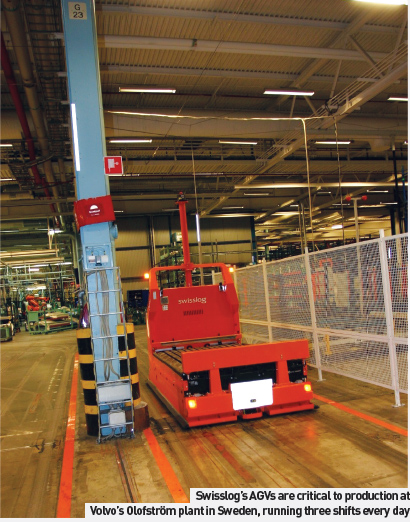
The specific use of automated guided vehicles between shipping dock and assembly line is offering carmakers safety-conscious production savings
Several decades ago, automated guided vehicles (AGVs) were being heralded as the ultimate answer to the material handling requirements of automotive OEMs. Plants such as Ford’s Cologne facility, with its legions of AGVs, were seen as a vision of the future. Today the reality comes somewhat short of that vision. Not that AGVs are scarce among the global automotive manufacturing facilities, but their use is more specific than the earlier hype promised. Today, typical AGV applications in the industry include automated raw material delivery and automated workin- process movements between manufacturing cells and finished goods transport. AGVs link shipping/receiving, warehousing and production with just-in-time part deliveries that minimise line side storage requirements. They can also help create the fork-free manufacturing environment, which many plants in the automotive industry are seeking.
But why do OEMs use AGVs? Given that they operate at half the speed of traditional forklift trucks and are more expensive to purchase, it would seem a tough sell. But as Pascal Milliot, General Manager of the Body Assembly Engineering Department at Renault explains: “We increasingly use AGVs in order to gain room along the assembly lines.”
Sometimes the real reason for using AGVs can get lost in the drive for technology. What’s the real reason? According to Mark Sharp, Director/Plant Manager at Nissan’s US facility in Smyrna, it is to make the job easier. “I think that there is a financial upside to greater application in body assembly. The goal was not AGV application; that was strictly a tool to support the ultimate goal of making the job easier for the end user – the body assembly technician, the individual putting parts into the vehicle. How do we do that? I think we look at that as we look at processes, changing processes, changing part suppliers, and the application of AGVs does support that, but that is not our ultimate goal, to just add AGVs to the process.
 Flexible conveyors
Flexible conveyors
One of the major AGV providers is FMC Technologies, and Greg Pachuta of the US supplier argues that AGV use has not declined. “True, the use of AGVs now is definitely on a case-by-case basis; nobody is doing an entire plant. However, I don’t think that it has died down but has remained steady. “They are used in a variety of ways now. Before, it was strictly material handling, moving parts from a shipping dock to the assembly line; now they are actually used in place of the assembly line. They have smaller vehicles that are part of the assembly of the seats or part of the assembly of an axle. That was a trend many years ago and now they have come full circle and are doing that again, but with very inexpensive AGVs.
“In effect it is replacing a conveying system. They are much more flexible than putting in a full conveyor in the middle of a plant. This way they just have magnetic strip tape that they use for guidance, which is very easy to pick up and move somewhere else.” This application is often seen in operations such as engine marriage with chassis, such as at BMW Leipzig and Volvo in Gent. Units can be delivered on AGVs, in sequence, ready to marry to the chassis that is moving along the production line on an overhead conveyor.
Choosing the right AGV
Rick Youngblood, Plant Manager, Truck Trim and Chassis, at Nissan Smyrna, has seen a growing market for AGVs. “I think that initially it was a novel idea that gained a lot of allies, just because it was a novel idea,” he says. “Going forward, we have to be very selective and very careful about what type of applications that we put those in. By that I mean that there are different types of AGVs that are available to us on the market.
“Some of those are simple magnetic-guided vehicles that just follow the track that you embed in the floor,” continues Youngblood. “Others have decision-making capabilities and are powerful enough to travel various distances, making stops based on the need of a particular part. I think there is definitely a market out there and a segment of our operations that those fit with. No doubt in the past there were manufacturers that tried to adapt AGVs for use in different areas and it didn’t work out so well; that’s normal trial and error in the growth process.”
In the early days of AGVs, magnetic-guided vehicles were less flexible, requiring wires buried under the floor, but by utilising magnetic tape the current breed can tick all the flexibility boxes. “Actually the magnetic-guided vehicles are more flexible because what we call a ‘dumb’ AGV doesn’t have a great deal of programming,” Youngblood says. “It basically follows a magnetic tape and that tape comes in a roll just as you would buy standard masking tape. It is very flexible; it’s a matter of just pulling the tape up and moving it to another area of the plant. So it is probably more flexible than the ‘smart’ AGVs, which are the ones that have the decision making capability, but it is surely a function of what is available in the programme itself rather than the flexibility.”
This distinction into ‘dumb’ and ‘smart’ is a good general guide for AGV applications in the industry. So-called dumb AGVs are basically simple systems, as Pachuta explains: “These are used more for moving short distances, moving at a very slow speed, moving very lightweight parts, and they also could be used in the assembly.”
These contrast with the more traditional, more heavyduty or industrial AGVs, used for material handling, taking parts to the assembly line and parts from one process to another.
Automatic unloading
A trend that Pachuta reports to seeing in other sectors, and something that the automotive industry is paying great attention to, is the automatic unloading of truck trailers. “As a truck pulls up we will automatically unload the whole trailer and deliver it out to the assembly line. The control system picks up the information from the trailer as it pulls up and has the right AGVs waiting at the dock, the vehicle can be automatically unloaded and the parts or assemblies moved to holding areas or delivered lineside. “I don’t know of any in the automotive industry at the moment, but other industries are using this method and the automotive industry is definitely looking at it now. Most of them are dedicated docks where the same part is delivered all of the time.
“We already have systems where parts, like engines, are never touched by a manual fork truck,” Pachuta says. “They automatically come off an automatic truck unloading system, not an AGV system, onto a conveyor inside the plant and we pick up the load and take it straight to the line. The empty racks are sent back to the conveyor system where they are pushed back into the trailer.”
Control systems
The control system of an AGV gives it its destination and tells it where to go next. “From that, you have complete tracking of where the vehicles are at all times,” says Pachuta. “You can monitor what is happening, how many loads have been moved a day, and what their battery level is. There is complete monitoring of the system through the system control. They’re typically computer-controlled and then from the computer we talk to the vehicles through radio technology.
“There is usually an interface to transfer information back and forth, but it is not very complicated. The plants always want to keep track of what is happening, so they want messages back and forth to say if the system is operational or non-operational. They may also want to pass information between one supplier, or from the supplier of the parts to the AGV system.”
The system usually operates in much the same way as a traditional Kanban system. However, instead of the manual signals, the operator can push a button to say that he is out of parts or use an automatic signal. “Most of it is regulated by the operator and in most cases, he pushes a button to say, ‘I am out of parts, can you bring me another one’,” explains Pachuta.
Final assembly
At Nissan in Smyrna, AGVs are predominantly used in final assembly. “We are using them more in the assembly portion of the building, particularly where we have sequenced delivery of parts to the line,” explains John Davenport, Department Manager for Body Assembly. “We are also using them in several applications where we are kitting. We send a kit of parts to the line to eliminate the walk to a supply rack for instance. We have a block kit of parts that accompany the vehicle through its process, including everything that a particular line would need to add to that vehicle.”
 Safety first
Safety first
Despite all the advantages of flexibility, the prime reason behind the adoption of AGVs is safety, as Greg Pachuta confirms. “In many companies, safety is the key feature,” he says. “The auto companies in the US, and I am sure all over the world, are doing studies of the cost of manual fork trucks and the lack of safety associated with dealing with them. AGVs have a stellar record for safety with all the electronic emergency bumpers that they have on board, they can sense things and stop if somebody walks in their way. So safety is the key issue.
“I am sure that there is still some push to reduce the cost of manual labour, so that helps. Then there’s flexibility of the AGVs – they are laser-guided, so you can move the vehicle past anywhere that you want.”
Future advances
As for future technologies for AGVs, the automatic truck unloading touched on earlier is the next big wave likely to revolutionise the market. “Being able to automatically unload truck trailers and deliver parts to the assembly line, being able to determine where the trailer is and automatically have the vehicles sense the trailer and adjust properly so that it can be automatically unloaded, that is definitely going to be a big help,” says Pachuta.
Pachuta goes on to say that there are two diverse paths that vendors are taking: simple and complex. “There are two extremes,” he explains. “One is to make them very simple and inexpensive so they can use them in many different fashions. Then there is the issue of making them more complicated or sophisticated, where you are able to use them for more things than manual fork truck drivers have done in the past.”
 Such is the demand for Volvo cars, the Swedish automotive giant could not afford to interrupt production, yet it needed to increase output while maintaining the company’s 80-year reputation for build quality. Like all carmakers, Volvo relies on automation, so the solution to increasing productivity at the company’s body-in-white plant in Olofström, Sweden, was to replace a fl eet of AGVs in a seamless upgrade programme that allowed almost uninterrupted car production. The AGVs were developed by Swisslog, its Finnish-based partner in AGV development, Rocla Robotruck and drive and control technology specialist Danaher Motion. The vehicles ensure that body parts are expediently transported to the production line, where they are fi tted together and welded at various stations. This takes place under the overall control of a host computer, with communications sent via a wireless local area network (WLAN) as orders are sent from the main assembly plant.
Such is the demand for Volvo cars, the Swedish automotive giant could not afford to interrupt production, yet it needed to increase output while maintaining the company’s 80-year reputation for build quality. Like all carmakers, Volvo relies on automation, so the solution to increasing productivity at the company’s body-in-white plant in Olofström, Sweden, was to replace a fl eet of AGVs in a seamless upgrade programme that allowed almost uninterrupted car production. The AGVs were developed by Swisslog, its Finnish-based partner in AGV development, Rocla Robotruck and drive and control technology specialist Danaher Motion. The vehicles ensure that body parts are expediently transported to the production line, where they are fi tted together and welded at various stations. This takes place under the overall control of a host computer, with communications sent via a wireless local area network (WLAN) as orders are sent from the main assembly plant.
Performance for production Volvo was an early adopter of AGV technology, but in 2004 it became clear that the mid- 1980s, wire-guided system needed replacing as part of an upgrade to the logistics fl ow. “The old AGVs were still running, but showing their age in their performance – in terms of ultimate speed and load-carrying capability – and it was becoming a limiting factor as Volvo sought to boost production,” says Christer Nilson, the Volvo engineer responsible for overseeing the exchange programme. “Also, wire-guided navigation makes it difficult to rearrange the plant to match the company’s changing needs and to increase flexibility. It was also foreseen that maintenance of such old systems would soon become an issue. “However, the AGVs are absolutely critical to production at Volvo, running three shifts every day. We certainly couldn’t afford to disrupt our logistics fl ow by simply taking all 13 of the old AGVs out of service and halting production while the new vehicles were commissioned.”
Strategic installation
Realising that minimising disruption to the logistics fl ow was absolutely critical to the successful replacement of the old AGVs, Volvo turned to the experts at Swisslog, the same company that had project-managed the initial AGV installation some 20 years earlier. Peter Bülow, Project Manager at Swisslog, proposed to minimise disturbance to production by adopting the more complex strategy of replacing the AGVs one by one. It required very careful planning, with each new AGV also having to meet stringent performance guidelines outlined by Volvo. From the outset, there had to be a high level of flexibility, combined with programming simple enough to allow each new vehicle to ease into the logistics fl ow with minimum commissioning time and effort. However, a favourable by-product of the scheme was the prorata purchase of each new vehicle as they entered service, rather than a costly one-off purchase, with all the associated difficulties of justifying the required capital expenditure.
Guidance software
The sequential vehicle replacement in the Volvo plant was made possible by the Danaher Motion NDC8 AGV control platform, the basis of the VMC500 vehicle controller and the heart of each new unit. The ability of the NDC8 to integrate with adjacent software systems, such as the existing stationary control system, meant old and new vehicles could be operated simultaneously if required. The software functions of the VMC500 control everything from navigation to communication via the AGV load operations and system controller. It incorporates a number of features vital for the control of automated vehicles, such as guidance functions, but with the flexibility to provide several options for navigation. Additionally, it supports state-of-the-art laser and spot magnetic free-ranging techniques, as well as traditional pilot-line guided technologies such as inductive wire or magnet tape guidance.
By autumn last year, eight new AGVs were operational and Volvo readily reaped benefi ts, as Peter Bülow explained. “Production was ramping up faster than expected, but the new AGV system immediately had the capacity to match the pace. Load handling time has been signifi cantly reduced thanks to Rocla’s design.” Initially, new vehicles operated at the same speed as the old AGVs (around 1m/s) to simplify the exchange but the eventual increase in speed (to 1.4m/s when all the old AGVs had been replaced) meant far higher transport flow. Motive power for each AGV – for steering, traction and load handling – is provided by DC or AC motors, precision controlled by servo amplifiers.
Single-platform solution
The increased performance of the new units has resulted in ten AGVs replacing the 13 original vehicles, while achieving a significant increase in overall productivity. However, a key reason for incorporating the controller was that it provided a control platform, a complete tool kit for the design partners to develop an AGV installation utilising technology proven in a wide range of industries. The single-platform solution minimises costs associated with project management, engineering and manufacturing. Arne Gustafsson, responsible for the daily operation of the AGVs at Volvo, was pleased that, even after 20 years, the original supplier, Swisslog, with the very same project manager, was able to come back and upgrade the system. Under the direction of Swisslog, Volvo staff has also undergone training to take full control of service, maintenance, trouble-shooting and reprogramming.
“The new AGVs were added to the system very quickly and easily, without any fuss, and the primary demand, minimal disturbance to production, was fulfilled,” Nilsson points out. “In addition to increased productivity, the new AGV system also reduced the operating costs.”


































